Oral
Elastography
ISMRM & SMRT Annual Meeting • 15-20 May 2021

| Concurrent 4 | 12:00 - 14:00 | Moderators: Jeong Lee & Ingolf Sack |
0027.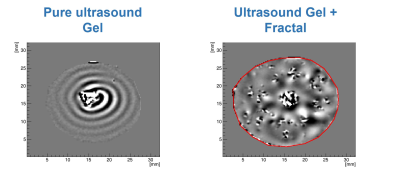 |
About the origin of viscosity in MR-Elastography: tissue absorption or vascular scattering?
Giacomo Annio1,2, Omar Darwish2, Elijah Van Houten3, Knut Solna4, Sverre Holm5, and Ralph Sinkus1,2
1LVTS, INSERM U1148, Paris, France, 2Department of Biomedical Engineering, King's College London, London, United Kingdom, 3Département de Génie Mécanique, Université de Sherbrooke, Sherbrooke, QC, Canada, 4Department of Mathematics, University of California at Irvine, Irvine, CA, United States, 5Department of Physics, University of Oslo, Oslo, Norway
MRE is a novel tool to study in-vivo biomechanics. Recently, the diagnostic value of viscosity has been explored. However, its physical origin as intrinsic absorption or due to scattering is yet unknown. This work shows that the majority of viscosity at about 100Hz is apparent, thus originating mainly from scattering. Moreover, we observed that the classical springpot model fails to describe the dispersion properties of complex media containing scattering structures. We propose a nonlocal viscoelastic model that can ultimately disentangle intrinsic loss effects from scattering-induced ones. This changes dramatically the way we interpret viscous changes for therapies impacting on vasculature.
|
||
0028.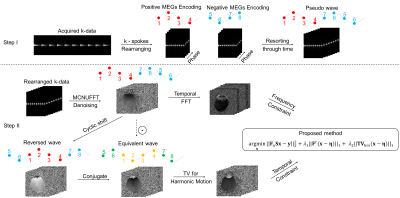 |
A Multiphase Radial DENSE Sequence and harmonic motion based compressed sensing for fast magnetic resonance elastography
Runke Wang1, Suhao Qiu1, Zhiyong Zhang1, and Yuan Feng1
1School of Biomedical Engineering, Shanghai Jiao Tong University, Shanghai, China
Accelerating magnetic resonance elastography (MRE) is desired for improved patient care and image quality. In this study, we proposed a multiphase radial DENSE MRE (MRD-MRE) sequence, and a compressed sensing based reconstruction algorithm using the sparsity of harmonic motion. A spatial modulation of magnetization (SPAMM) shot was applied for motion encoding together with a radial sampling scheme for acceleration. Reconstruction accuracy was improved by utilizing the temporal sparsity of harmonic motion. Phantom and brain imaging showed that an acceleration factor up to 4 could be reached.
|
||
0029.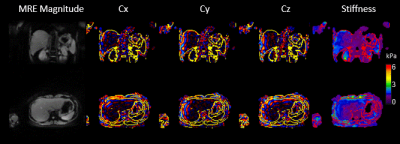 |
Respiratory Motion-Resolved Free-Breathing MR Elastography Of Liver
Yi Sui1, Jiahui Li1, Joshua D. Trzasko1, Arvin Arani1, Kevin Glaser1, Phillip J. Rossman1, Ziying Yin1, Meng Yin1, and Richard L. Ehman1
1Radiology, Mayo Clinic, Rochester, MN, United States
A free-breathing hybrid radial-cartesian 3D MRE technique (TURBINE-MRE) was developed for MR elastography of the liver. This technique provides motion-resolved wave images and stiffness maps in single 4-minute free breathing acquisition. The feasibility of the new technique was demonstrated in healthy volunteers and a NASH patient with hepatic cirrhosis.
|
||
0030.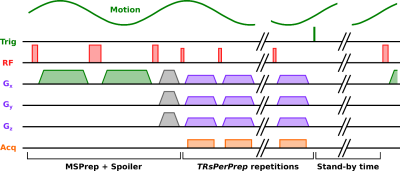 |
Prepared MR Elastography
Tanguy Boucneau1, Brice Fernandez2, Luc Darrasse1, and Xavier Maître1
1Université Paris-Saclay, CEA, CNRS, Inserm, BioMaps, Orsay, France, 2Applications & Workflow, GE Healthcare, Orsay, France
By decoupling motion and spatial encoding, magnitude contrast MR Elastography could be performed for the first time at ultrashort echo times (12 µs). On the basis of a motion-sensitizing magnetization preparation, the available total magnetic moment is sensitized to the motion induced in the tissues so the information can be efficiently carried over by the MR signal magnitude when the selected imaging pulse sequence is applied. The new paradigm allows also for shorter total acquisition times as demonstrated here in a set of homogeneous and heterogeneous phantoms with up to 5-fold acceleration factors.
|
||
 |
0031.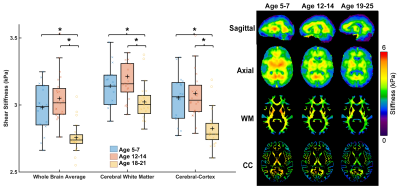 |
Regional Brain Mechanical Properties Throughout Maturation from Childhood to Adulthood
Grace McIlvain 1, Julie M Schneider2, Melanie A Matyi 3, Melissa S DiFabio1, Peyton L Delgorio1, Matthew DJ McGarry 4, Jeffrey M Spielberg3, Zhenghan Qi2, and Curtis L Johnson1
1Biomedical Engineering, University of Delaware, Newark, DE, United States, 2Department of Linguistics, University of Delaware, Newark, DE, United States, 3Department of Psychology, University of Delaware, Newark, DE, United States, 4Thayer School of Engineering, Dartmouth College, Hanover, NH, United States
Brain mechanical properties are markers of microstructural health and have been extensively studied in neurodegeneration using MR elastography. However, brain mechanical changes during maturation have yet to be comprehensively explored. Here we present preliminary findings from an ongoing study which uses OSCILLATE, a fast acquisition, high-resolution sequence to characterize brain mechanical properties in people ages 5-21. We present notable regional brain mechanical property differences during development and aim to categorize brain mechanical property developmental trajectories in major anatomical structures. This data will provide a platform for brain mechanical property comparison when studying atypical maturation.
|
|
0032.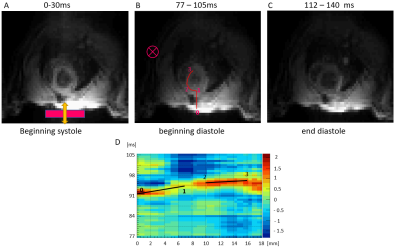 |
Quantification of in-vivo myocardial stiffness in the rat heart using transient mechanical waves
Anna Sophie Wittgenstein1, Marco Barbero Mota2, Giacomo Annio2, Guillaume Rucher2, Rachida Aid-Launais2, Rami Mustapha3, David Alexander Nordsletten1,4, and Ralph Sinkus1,2
1School of Biomedical Engineering and Imaging Sciences, King's College London, London, United Kingdom, 2INSERM-Université de Paris, Paris, France, 3chool of Cancer and Pharmaceutical Sciences, King's College London, London, United Kingdom, 4Department of Biomedical Engineering and Cardiac Surgery, University of Michigan, Ann Habor, MI, United States
In vivo assessment of biomechanical properties in the left ventricle carries substantial promises for disease characterization. Its proper quantification, however, is far from straightforward. We propose an ECG-gated 3D CINE GRE sequence with motion encoding gradients (TR=7ms) and time-shifted mechanical excitation to quantify the propagation of transient shear waves at a temporal resolution of 0.7ms. In-vivo results in anesthetised rats show apparent shear waves speeds around 8m/s at mid diastole, compatible with recent human in-vivo data.
|
||
 |
0033.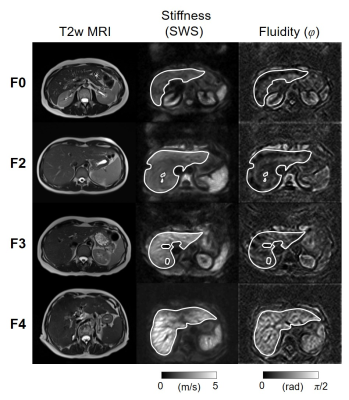 |
Stiffness and Fluidity of Hepatic Fibrosis Elucidated by In Vivo Multifrequency MR Elastography
Rolf Reiter1, Mehrgan Shahryari1, Heiko Tzschätzsch1, Matthias Haas1, Christian Bayerl1, Britta Siegmund2, Bernd Hamm1, Patrick Asbach1, Jürgen Braun1, and Ingolf Sack1
1Radiology, Charité - Universitätsmedizin Berlin, Berlin, Germany, 2Gastroenterology, Charité - Universitätsmedizin Berlin, Berlin, Germany
We aimed to investigate the solid-fluid behavior of hepatic fibrosis and cirrhosis using multifrequency MR elastography. Despite the success of stiffness-based assessment of hepatic fibrosis, little is known about tissue’s solid-fluid behavior upon fibrosis. Although cirrhosis is associated with liver stiffening and, intuitively, transition towards more rigid material properties, the observed increases in fluidity and slope of shear-wave-speed-dispersion indicate abnormally high mechanical friction in cirrhotic livers. This biophysical signature might provide a prognostic imaging marker for the detection of end-stage fibrosis independent of stiffness.
|
|
0034.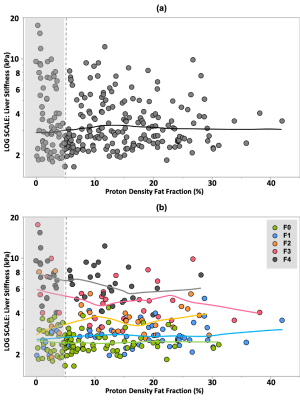 |
Liver Stiffness Measurement by Magnetic Resonance Elastography is not Affected by Hepatic Steatosis
Jie Chen1,2, Alina Allen3, Terry Therneau4, Jun Chen2, Jiahui Li2, Jingbiao Chen2, Xin Lu2, Zheng Zhu2, safa Hoodeshenas2, Sudhakar Venkatesh2, Bin Song1, Richard Ehman2, and Meng Yin2
1Department of Radiology, West China Hospital, Sichuan University, Chengdu, China, 2Department of Radiology, Mayo Clinic, Rochester, MN, United States, 3Devision of Gastroenterology and Hepatology, Mayo Clinic, Rochester, MN, United States, 4Devision of Biomedical Statistics and Informatics, Mayo Clinic, Rochester, MN, United States
In a cross-sectional study, we investigated the relationship between pathology-assessed hepatic steatosis, MRI-assessed PDFF, and LSM with MRE in a large NAFLD population. No significant differences in LSM was found between patients with S1, S2, and S3 steatosis, and between all steatosis grades after patients were grouped according to fibrosis stage. After adjusting with fibrosis stage and age, there was no statistically significant relationship between liver stiffness and PDFF in patients with diagnosed steatosis (i.e., PDFF≥5%). LSM by MRE is not biased by increased liver fat content.
|
||
0035.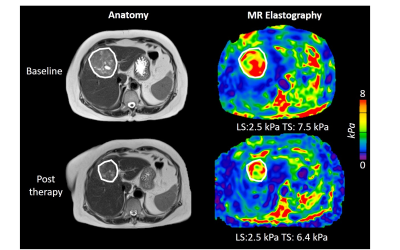 |
Tumor stiffness and stiffness change using 3D MR elastography are markers of tumor lymphocyte infiltration and immunotherapy response in HCC.
Paul Kennedy1, Muhammed Shareef1, Octavia Bane1, Guillermo Carbonell1, Elizabeth Miller2, Israel Lowy2, Stephen Ward1, M. Isabel Fiel1, Miriam Merad1, Thomas Marron1, and Bachir Taouli1
1Icahn School of Medicine at Mount Sinai, New York, NY, United States, 2Regeneron Pharmaceuticals Inc., Tarrytown, NY, United States
In this prospective study we correlated tumor stiffness measured in hepatocellular carcinoma with density of tumor infiltrating lymphocytes and assessed the changes in tumor stiffness in patients undergoing neoadjuvant immunotherapy prior to liver resection. We found that tumor stiffness strongly correlates with grade of tumor infiltrating lymphocytes, and that changes in tumor stiffness correlate with histopathologic response.
|
||
0036.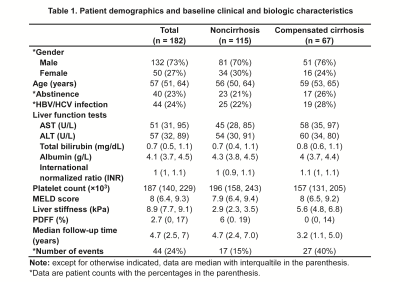 |
Value of Liver MR Elastography for Predicting Development of Cirrhosis and Decompensation in Patients with Alcohol-associated Liver Disease
Jingbiao Chen1, Mahmoud Adam Tahboub Amawi2, Xin Lu2, Jie Chen3, Jiahui Li2, Zheng Zhu2, Safa Hoodeshenas2, Jin Wang4, Douglas A Simonetto2, Vijay H Shah2, Richard L Ehman2, and Meng Yin2
1Radiology, the Third Affiliated Hospital of Sun Yat-sen University, Guangzhou, China, 2Mayo Clinic, Rochester, MN, United States, 3West China Hospital, Chengdu, China, 4the Third Affiliated Hospital of Sun Yat-sen University, Guangzhou, China
Identifying those at high risk for the development of end-stage liver disease in patients with alcohol-associated liver disease (ALD) is of great clinical importance. We retrospectively investigated the role of MR elastography (MRE) in predicting cirrhosis or decompensated cirrhosis on a cohort of 182 ALD patients. Our preliminary results indicated that liver stiffness measured by 2D-MRE is a significant and independent prognostic factor for the future development of cirrhosis or decompensated cirrhosis. These results echoed the previous findings in other etiologies and reinforced the prognostic value of MRE in predicting advanced liver disease, which facilitates early intervention for ALD.
|
The International Society for Magnetic Resonance in Medicine is accredited by the Accreditation Council for Continuing Medical Education to provide continuing medical education for physicians.